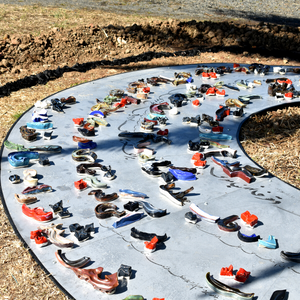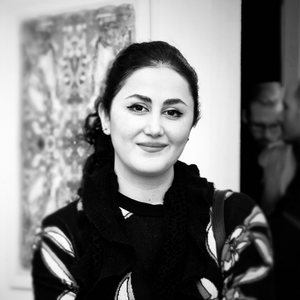Exilica (2022)
Ceramic and Zincanneal Sheet

Exilica examines cultural identity, loss, and grieving issues, emphasising existential exile experiences. For this site-responsive installation, I crafted each ceramic piece in Farsi letters and alphabets, creating an allegorical poem to commemorate the soldiers who passed away during the First and Second World Wars, and their graves are in the Rookwood Cemetery. As their honourable existences in the past enrich our lives now, these textual sculptures have been placed around a palm tree on the ground, as a metaphor to generate multi-layered meaningful narratives for contemplation, mourning, and remembrance.
Exilica - English translation of Farsi poem
My throat is full of sleeping swallows
The sky is empty, and you didn’t come home.
I looked into your hopeful eyes in the picture frame
And time lost its meaning
Because of your love
The sea will remember you.
My heart is full of silent red poppies
You intended to live fully with the dream of peace
Until you have heard the rivers roar
Until you have seen the dance of magnolia blossoms
To the earth’s glory
Calling children out to play
The sun will remember you.
(Farnaz Dadfar, 2021)
About the Artist
 Born in Tehran, Farnaz Dadfar is an interdisciplinary artist who now lives on Gadigal Country in Sydney. Her researchbased practice is informed by material, place, and history through a lens of migration. Farnaz has exhibited in galleries and museums in Iran, Australia, and Indonesia; such as Saba Cultural Artistic Institute Tehran, QUT Art Museum Brisbane, Linden new Art Melbourne, and Sarang Building Yogyakarta. She has received numerous awards, including Anne Runhardt Art Award Notfair, The University of Sydney RTP Scholarship, The David Richards Drawing Award, and the VCA Galloway Lawson Prize. Farnaz is currently a PhD candidate at SCA, The University of Sydney.
Born in Tehran, Farnaz Dadfar is an interdisciplinary artist who now lives on Gadigal Country in Sydney. Her researchbased practice is informed by material, place, and history through a lens of migration. Farnaz has exhibited in galleries and museums in Iran, Australia, and Indonesia; such as Saba Cultural Artistic Institute Tehran, QUT Art Museum Brisbane, Linden new Art Melbourne, and Sarang Building Yogyakarta. She has received numerous awards, including Anne Runhardt Art Award Notfair, The University of Sydney RTP Scholarship, The David Richards Drawing Award, and the VCA Galloway Lawson Prize. Farnaz is currently a PhD candidate at SCA, The University of Sydney.
Transcription
My name is Farnaz Dadfar and I am an interdisciplinary artist currently based on Gadigal country.
I worked with mediums of installation, text and video to examine cultural identity and post colonial issues and drawing from personal narrative, I explore the concept of linguistic diaspora and the idea of flaneur through the lens of displacement and migration, and for this experimental project titled Exilica, I sort of create a poem which resonates cultural identity, loss and grieving issues, are emphasizing on existential exile experiences and for this site specific or perhaps site responsive installation.
I crafted each ceramic pieces in Farsi letters and alphabets and try to create an allegorical poem to commemorate soldiers who passed away during the First and Second World wars and their graves are actually in the Rookwood Cemetery, as their honourable existence in the past enriches our lives now. These sort of textual sculptures have been placed around the palm tree in a roundabout underground as a metaphor to generate multilayered, meaningful narratives for contemplation remembrance and mourning.
Exilica relates to the historical side of Rookwood Cemetery, in which the work echoes as a visceral exploration of a statelessness and drifting sort of concepts. So these poems like sort of individually crafted each piece, pieces, as letters and alphabets. They are made out of clay and, you know, fired several times in the in the kill, and as a sort of embodiment of incarnating otherness. So the work is about fragmentations and displacement of the Farsi language. It's a way of diffractions and refractions of words and meanings from the past to the present.
So conceptually work with the idea of sort of recuperating or going from one stage of being to another stage of being, from the past to the present. So the poem would be placed as a sort of a concentric circular ways around a palm tree in one of the in one of Rookwood's roundabout. By making this work, I mean I I aim to create and sort of an immersive textual space for audiences to wander and throughout the historic site of the cemetery.
The project sort of reflects on the journey of human existence between being and not being, and try to emphasise the notion of exile and separation and displacement as we live in the alienated twenty one century existence. I mean by the way of looking, they sort of unconsciously walking around the work. So, it's a a conceptual metaphor that they will wander through this area unconsciously. Yeah, that's sort of a part of, part of the concept of the work.